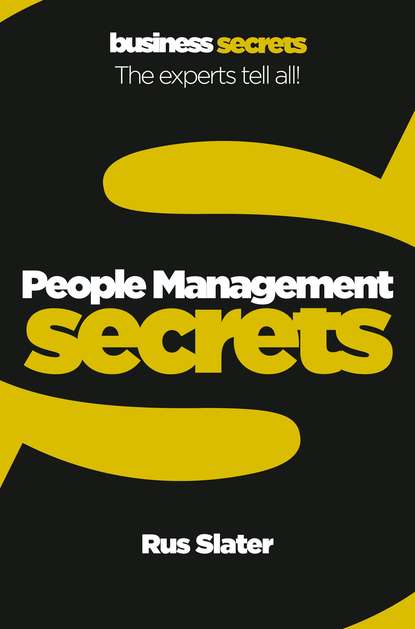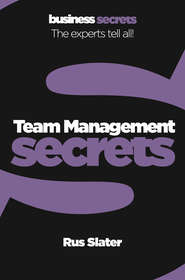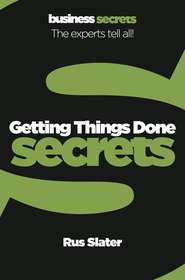По всем вопросам обращайтесь на: info@litportal.ru
(©) 2003-2024.
✖
People Management
Автор
Год написания книги
2019
Настройки чтения
Размер шрифта
Высота строк
Поля
“Tell them what you want [Objectives], reward them for it [Motivation], and get out of the way” [Trust]Gordon Bethune, former CEO of Continental Airlines
Agree objectives, check people are motivated and then get out of the way!
1.8 Create a ROWE (#ulink_68b18036-14a4-53fb-9988-e2c94f076832)
A Results Orientated Work Environment – or ROWE for short – is a new idea that is gaining ground in the information and Internet age. The main principle behind ROWE is to create a working environment that is orientated to recognizing and rewarding results rather than time.
In order to create a ROWE, the manager has to set specific, measurable objectives that lead to results that can be tested and accepted. (See Chapter 3 for more about setting objectives.) The key concept in a ROWE is the quality standard by which you, the manager, will assess whether the task has been completed, and therefore whether the reward for it will be released.
Obviously the faster a person can complete a task to the required standard, the sooner they earn the reward. This challenge in itself encourages people to work with a higher level of motivation.
ROWE doesn’t work for all roles. For example, a shop assistant has to be present while the shop is open, even if there are no customers. However, for roles that can be done on a ROWE basis, the approach has distinct benefits.
one minute wonder Consider what you want the people who work for you to achieve…today…and this week. Does it really require them to be in the office, or is being in the office actually a hindrance to their achievement? If so…think ROWE!
• People can manage their own workloads and don’t need to ask your permission to come and go. Therefore you don’t need to constantly supervise and monitor their work rate and attendance.
• People can earn more if they want to, which is another motivating factor.
• Reward is based on actual output, not hours, so productivity is very likely to rise.
• ROWE increases everyone’s focus on quality.
• ROWE is an adaptive solution to overwork – people are less likely to take on work they do not intend to complete.
ROWE works best if the people you manage are not a team, and the output of each is independent of others. However, you can create a team ROWE – a team of bricklayers, for example, can agree a ‘contract price’ for the job. They will be far more reliable than a team of bricklayers paid by the hour who have, by definition, a vested interest in dragging out the job to take up more hours.
A work environment orientated to results has many benefits over one based on the number of hours worked.
Create a great team (#ulink_3e298b83-dc04-54c8-9aae-d46323917834)
If you have the opportunity, form your people into a team. Teams don’t occur naturally; you have to make a concerted effort to develop a team ethos. This chapter is mostly concerned with creating a team from a group of individuals. The whole point of a team is ‘synergy’, which means that the whole is greater than the sum of the parts. In other words, teamwork will produce a better result than when individual people work towards individual goals.
2.1 AIM to pick the right person for the job (#ulink_5c1f131b-6fe4-5e73-81a8-c6c48343c625)
Managing people is a whole lot easier if you have the right people from the outset. If you have the opportunity to pick and choose your people, then this secret will help you to take advantage of that opportunity. There are three fundamental steps to picking the right people – Assess, Identify and Motivate – or AIM for short.
1 Assess what ‘right’ is. Analyse what you want this person to do and create a Job Description. What level of skills and knowledge do they need? For instance, does this person need to be ‘familiar with’ or ‘expert with’ Microsoft Office Tools? What personal attributes will they need to be successful and satisfied? If the team is working in an ever-changing environment, you will need a different type of person to someone who would suit a team whose predominant environment is bureaucratic and slow moving. What type of person will fit in with your style of management? If you like empowering people, someone who needs constant reassurance will be unhappy. What type of person
“Genius is the ability to pick the right person for the job and then let them get on with it” Anonymous
will fit in with the other team members? This is tricky, because sometimes someone who is similar is best, and at other times someone who complements the other team members is best.
2 Identify your options and identify the ‘right’ person. Now you have to find some potential recruits. You can use the answers you came up with in section 1 above to draft an advertisement that helps people to know if they are qualified and whether the job is the type they’d want. Once you have some people to interview, you can again use the answers from section 1 to help you find and assess evidence of the person’s competence to do what you need them to do.
3 Motivate that person to want to join your team. Once you have found the person you think is right, you have to ‘sell’ them the opportunity. Up until now you have been focusing on your needs, but now you need to focus on their needs. See Secret 4.3 to help you here.
You will notice that the three steps above – Assess, Identify, Motivate – spell out the word AIM. It is rather like throwing a basketball – if you AIM properly you will score!
Pick the right person for the job, and they will be a happy person, which in turn will make you a happy manager!
2.2 Get the team performing quickly (#ulink_5c8344a6-4308-5d2d-8f97-bea8b36ed02d)
The ‘Tuckman Model’ identifies several stages that a team goes through before it starts performing properly. The stages – referred to as Forming, Storming, Norming and Performing – will happen naturally, but you can speed up the process.
1 Forming stage. Forming is the introduction process, when people are literally finding out who is who, learning names, job titles, roles and ranks, and other people’s history. In order to get this stage successfully completed as quickly as possible, deliberately hold a ‘forming’ meeting. Ask everyone to introduce themselves and share this information.
case study A manager asked me to run a teambuilding course for his part-time IT project team. The team had spent 11 months and many thousands of pounds but had achieved nothing at all. Over two days of teambuilding, the team members properly introduced
2 Storming stage. The stage where, confident they are meant to be here, people start to ‘jockey for position’ – to establish their credibility in the team. Some will try to push themselves forward because they want power or influence; others will deliberately keep a low profile because they are shy, diffident or lacking in confidence. You need to set up activities that allow people to find their level of comfort – for example any of the teambuilding exercises you can find on websites such as www.businessballs.com.
3 Norming stage. This is when you start to establish the rules of behaviour between team members, and their relationships with you and people outside. The Norming phase can take quite a long time if left to happen naturally because the rules will be established by a combination of ‘trial and error’ and ‘custom and practice’. Take control by holding a team meeting to set up a formal ‘team charter’. See Secret 2.4 for more details.
4 Performing stage. Performing is the stage when the team is getting on with the tasks in hand. Milestones are reached, targets are met, internal friction is minimal, people are smiling and achieving.
Help your people get through the early stages of teambuilding quickly.
themselves to each other for the first time; they did a couple of exercises that allowed them to ‘storm’; and they produced their own team charter. They went on to achieve more in the following six weeks than they had in the previous 11 months.
2.3 Create a team identity (#ulink_2b1de6fe-d54a-53b4-ac54-20230766d56c)
Sports teams nearly always have a team name, whether it’s British Lions (rugby union team), the Mumbai Champs (cricket team), the Tianjin Lions (baseball team) or the Mamelodi Sundowns (soccer team). Teams have names because it gives them a sense of being a team and it makes the members feel as if they ‘belong’!
Even if the people on your team are scattered across several departments of the organization, they can work together happily if they have a sense of shared identity. You should create a team identity – a team name, a team logo, a team motto, a team vision and even a team ‘strip’ or uniform.
Get your team together and suggest the idea: they’ll probably like it. You can ask them to work in pairs or small groups to select an appropriate name, devise a logo, think up a motto and design a ‘uniform’. They can each present their suggestions to the rest of the team and you can have a vote for the most popular. Opposite are some guidelines you can give them.
• Team name. Keep it short and simple, for example The ‘Hey!’ Team rather than the Global Internal Corporate Communications Team. Go for something descriptive of the team’s role or style, such as The Paper Tigers for an archive team. Try to find something different or even unique. Whereas lots of organizations have a Quality Team, why not call it The DriFTers, standing for Do it Right First Time? Alliterative or punning names are usually successful – the Rajasthan Royals or Coach and Courses for your training team. Also make sure the name is easy to pronounce and spell in the language your team uses – a good example of a ‘team’ that adopted an easier name identity is the British Royal Family, who changed their surname from Saxe-Coburg-Gotha to Windsor in 1917.
• Team logo. Keep the logo simple so that it stays recognizable when reduced in size on memos or polo shirts. Ideally, create one in black and white or primary colours so it can easily be photocopied and replicated if you want to have it embroidered, painted or printed. Look at famous logos like UPS, Chanel, Citroën, Nike, Puma, BMW or the BBC for inspiration – all use simple, strong shapes and colours.
• Team motto. Keep it short and informative of the team ethos. Think about famous slogans such as Avis’s “We try Harder”.
• Team ‘uniform’. You can create a team ‘uniform’ with clothing and accessories, such as hats, polo shirts, badges, buttons, umbrellas, document bags, and so on. Items such as these are all relatively cheap, unisex and often more popular and fun than a top-to-toe uniform.
Get your people involved in creating a team identity.
2.4 Create a team charter (#ulink_4bc54ba9-947b-5d4a-a798-5aa44591baba)
In Secret 2.2 we looked at the Tuckman Model (Forming, Storming, Norming and Performing). The creation of a team charter will help you through the Storming and Norming phases, allowing people to get on with the business of Performing.
A team charter is a set of rules, or norms of behaviour, that clearly sets out the acceptable behaviour among members of the team (including you as the team leader). Depending on the circumstances, it might also set out acceptable behaviour to other ‘stakeholders’ – internal departments, customers, competitors, shareholders, patients and so on.
Вы ознакомились с фрагментом книги.
Приобретайте полный текст книги у нашего партнера:
Приобретайте полный текст книги у нашего партнера:







